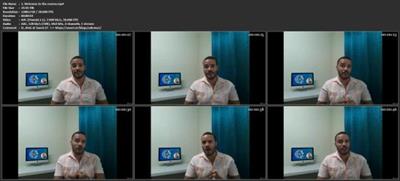Data Science for Healthcare Claims Data (updated 6/2021)
- 24.06.2021
- 127

MP4 | Video: h264, 1280x720 | Audio: AAC, 48000 Hz
Language: English | Size: 3.60 GB | Duration: 6h 58m
Language: English | Size: 3.60 GB | Duration: 6h 58m
What you'll learn
In this course, you will learn and practice, how to transform raw healthcare claims data into valuable knowledge and actionable insights.
Requirements
The components of this course that are dedicated to improving domain knowledge in the area of healthcare claims data are at beginner level. The components of this course that are dedicated to the application of data science tools on healthcare claims data are at an intermediate level. Some experience with transforming raw administrative data into actionable insights will be useful, but is not necessary.
Students will need a computer with access to internet in order to perform the practical parts of this course.
The majority part of this course does not require prior knowledge. However, a limited amount of parts of this course consists of data processing and analyzing using Excel, SQL, Python and business intelligence dashboards. For these parts only, prior knowledge and or familiarity with these tools is helpful, as this course may not provide you with enough information to learn these tools from scratch. This is due to the fact that the focus of this course is on the application of these tools to healthcare claims data, and not necessarily on learning how to work with these tools. There are many learning resources specifically dedicated to learning these tools. One of the concepts however, namely process mining, will be explained in more detail, because the learning resources about that field are relatively scarce. For process mining, we will be using Celonis Snap.
If you are already very familiar with machine learning in Python, the part of this course dedicated to machine learning may feel oversimplified. However, the purpose of this course is not to teach machine learning in Python. The main purpose of these parts is to showcase how we can transform raw healthcare claims data in such a way that we can apply meaningful machine learning techniques on it. This is also known as feature engineering.
Description
The most commonly available and widely used type of data in healthcare is claims data. Claims data is sometimes also called 'billing data' or administrative data. The reason why claims data is the most large scale, reliable and complete type of big data in healthcare is rather straightforward. It has to do with reimbursement, that is, the payment of health care goods and services depends on claims data. Healthcare providers may not always find the time to fill in all required paperwork in healthcare, but they will always do that part of their administration on which their income depends. Thus, in many cases, analyzing healthcare claims data is a much more pragmatic alternative for extracting valuable insights.
Claims data allows for the analysis of many non-biological elements pertaining to the organization of health care, such as patient referral patterns, patient registration, waiting times, therapy adherence, health care financing, patient pathways, fraud detection and budget monitoring. Claims data also allows for some inferences about biological facts, but these are limited when compared to medical records.
By following this course, students will gain a solid theoretical understanding of the purpose of healthcare claims data. Moreover, a significant portion of this course is dedicated to the application of data science and health information technology (Healthcare IT) to obtain meaningful insights from raw healthcare claims data.
This course is for professionals that (want to) work in health care organizations (providers and payers) that need to generate actionable insights out of the large volume of claims data generated by these organizations. In other words, people that need to apply data science and data mining techniques to healthcare claims data.
Examples of such people are: financial controllers and planners, quality of care managers, medical coding specialists, medical billing specialists, healthcare or public health researchers, certified electronic health records specialist, health information technology or health informatics personnel, medical personnel tasked with policy, personnel at procurement departments and fraud investigators. Finally, this course will also be very useful for data scientists and consultants that lack domain knowledge about the organization of healthcare, but somehow got pulled into a healthcare claims data project.
The instructor of this course is Dennis Arrindell, MSc., MBA. Dennis has a bachelor's degree in Public Health, a master's degree in Health Economics and a Master's degree in Business Administration.
Upon completion of this course, students will be able to contribute significantly towards making healthcare organizations (providers and payers) more data driven.
What this course is NOT аbout:
- Although we will be applying some important statistics and machine learning concepts, this course is NOT about statistics or machine learning as a topic on itself.
- Although we will be using multiple software tools and programming languages for the practical parts of this course, this course is NOT about any of these tools (Excel, SQL, Python, Celonis for process mining) as topics on themselves.
Who this course is for:
This course is for professionals that are involved with healthcare providers and health insurers that need to generate actionable insights out of the large volume of claims data generated by these organizations. Examples are: financial controllers and planners, quality of care managers, medical coding specialists, medical billing specialists, healthcare or public health researchers, certified electronic health records specialist, health information technology or health informatics personnel, medical personnel tasked with policy, personnel at procurement departments and fraud investigators. Finally, this course will also be very useful for data scientists and consultants that lack domain knowledge about the organization of healthcare, but somehow got pulled into a healthcare claims data project.
Screenshots

Download link:
rapidgator_net:
https://rapidgator.net/file/36af595fa633cb7069842658663603dd/e4h9r.Data.Science.for.Healthcare.Claims.Data.updated.62021.part1.rar.html
https://rapidgator.net/file/1db0239ddfad880d55997dc8d69a594a/e4h9r.Data.Science.for.Healthcare.Claims.Data.updated.62021.part2.rar.html
https://rapidgator.net/file/908ffdc9d1a70b2655d1e739ab25d691/e4h9r.Data.Science.for.Healthcare.Claims.Data.updated.62021.part3.rar.html
https://rapidgator.net/file/4a2832e3916aa1a75d9d4a3f9ea4965d/e4h9r.Data.Science.for.Healthcare.Claims.Data.updated.62021.part4.rar.html
uploadgig_com:
https://uploadgig.com/file/download/31c1665cD02A0B9c/e4h9r.Data.Science.for.Healthcare.Claims.Data.updated.62021.part1.rar
https://uploadgig.com/file/download/42f6C1412C23fdb5/e4h9r.Data.Science.for.Healthcare.Claims.Data.updated.62021.part2.rar
https://uploadgig.com/file/download/b4af0168C18eCD6f/e4h9r.Data.Science.for.Healthcare.Claims.Data.updated.62021.part3.rar
https://uploadgig.com/file/download/24c27Fc6842a096d/e4h9r.Data.Science.for.Healthcare.Claims.Data.updated.62021.part4.rar
nitroflare_com:
https://nitro.download/view/F30849F35851CFE/e4h9r.Data.Science.for.Healthcare.Claims.Data.updated.62021.part1.rar
https://nitro.download/view/B8CAE721512CAE0/e4h9r.Data.Science.for.Healthcare.Claims.Data.updated.62021.part2.rar
https://nitro.download/view/056EED8E2EE44DA/e4h9r.Data.Science.for.Healthcare.Claims.Data.updated.62021.part3.rar
https://nitro.download/view/69A87B019139AC8/e4h9r.Data.Science.for.Healthcare.Claims.Data.updated.62021.part4.rar
https://rapidgator.net/file/36af595fa633cb7069842658663603dd/e4h9r.Data.Science.for.Healthcare.Claims.Data.updated.62021.part1.rar.html
https://rapidgator.net/file/1db0239ddfad880d55997dc8d69a594a/e4h9r.Data.Science.for.Healthcare.Claims.Data.updated.62021.part2.rar.html
https://rapidgator.net/file/908ffdc9d1a70b2655d1e739ab25d691/e4h9r.Data.Science.for.Healthcare.Claims.Data.updated.62021.part3.rar.html
https://rapidgator.net/file/4a2832e3916aa1a75d9d4a3f9ea4965d/e4h9r.Data.Science.for.Healthcare.Claims.Data.updated.62021.part4.rar.html
uploadgig_com:
https://uploadgig.com/file/download/31c1665cD02A0B9c/e4h9r.Data.Science.for.Healthcare.Claims.Data.updated.62021.part1.rar
https://uploadgig.com/file/download/42f6C1412C23fdb5/e4h9r.Data.Science.for.Healthcare.Claims.Data.updated.62021.part2.rar
https://uploadgig.com/file/download/b4af0168C18eCD6f/e4h9r.Data.Science.for.Healthcare.Claims.Data.updated.62021.part3.rar
https://uploadgig.com/file/download/24c27Fc6842a096d/e4h9r.Data.Science.for.Healthcare.Claims.Data.updated.62021.part4.rar
nitroflare_com:
https://nitro.download/view/F30849F35851CFE/e4h9r.Data.Science.for.Healthcare.Claims.Data.updated.62021.part1.rar
https://nitro.download/view/B8CAE721512CAE0/e4h9r.Data.Science.for.Healthcare.Claims.Data.updated.62021.part2.rar
https://nitro.download/view/056EED8E2EE44DA/e4h9r.Data.Science.for.Healthcare.Claims.Data.updated.62021.part3.rar
https://nitro.download/view/69A87B019139AC8/e4h9r.Data.Science.for.Healthcare.Claims.Data.updated.62021.part4.rar
Links are Interchangeable - No Password - Single Extraction